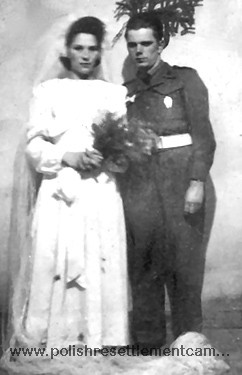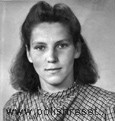| |
|
BACKGROUND
TO MY PARENTS CIRCUMSTANCES. |
|
|
|
A brief account sent in by
Daughter Teresa Stolarczyk-Marshall |
|
|
|
In 1939 Germany invaded Poland
displacing thousands of people and tearing families
apart. My father Józef Stolarczyk was 14 years old when
he was taken from his family home in Tarnowskie Góry
for forced labour
on a farm in Germany. He worked there for three
years before escaping with a French fellow worker to
France. After the allied invasion in Normandy he heard
that a Polish unit (Gen. Maczek's 1st Armoured Division)
was fighting alongside the allies and decided to join.
He was sent to Scotland for some army training and then
fought in the 1st Armoured Division in Germany and at
the end of the war was guarding a displaced persons
camp. |
| |
|
My mother Juliana
Łabińska
age 13 was also taken to Germany to work on a farm as
forced labour. When the war ended she was alone and
homeless. She was told that her village Czuczmany Zabłotne
near Lwów was destroyed and her
family had perished. That is how she found herself in
the same Displaced Persons camp that my father was
guarding. They married and I was born in 1946. They
were now faced with a dilemma, go back to Poland which
was now under communist rule or start a new life in
England. My father had some contact with his family in
Poland but my mother had no one so they came to England
although all their lives they regarded Poland as "home". |
|
|
|
|
|
|
|
|
HAYDON PARK CAMP |
|
|
|
We came over to England in August 1947 and
were taken straight to Haydon Park Camp. Other than my cot, pram
and some clothes, we had nothing. We were housed in a nissen hut,
the huts were divided in the middle with two families living in a
hut. They were furnished with basic army surplus furniture eg.
beds, chairs, table and some bedding. Accommodation was cramped
and the heating was minimal, a little cast iron coke burning
stove, so of course we were cold. Cooking facilities in the huts
were sufficient for breakfast and snacks but there was a communal
canteen which provided two meals a day. On arrival we were given a
small amount of money but everyone was expected to find work.
Finding work was difficult. My father was initially employed as a
kitchen porter in the camp. The pay was very poor but as he knew
some English which he learnt in the army he soon found work in a
tanning factory. This was very hard work and he had constant
problems with the effect of chemicals on his hands. My mother on
the other hand spoke no English at all but she found work in
Yeovil in a glove factory where she worked with some other Polish
ladies from the camp. |
| |
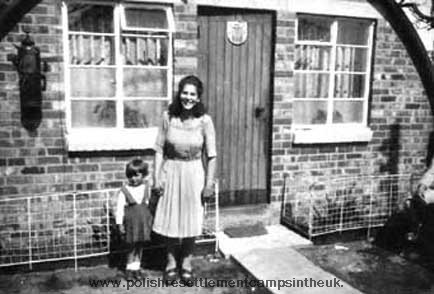 |
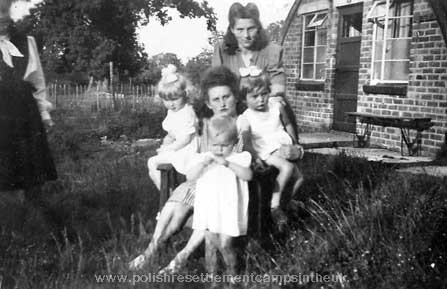 |
|
My mother and me outside
our Nissen hut home |
My mother, me and
friends in the camp |
|
| |
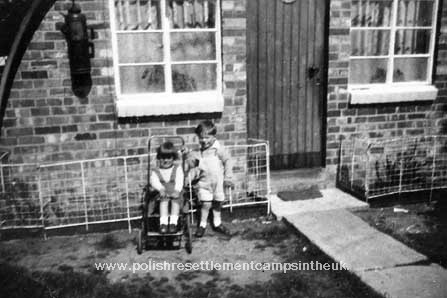 |
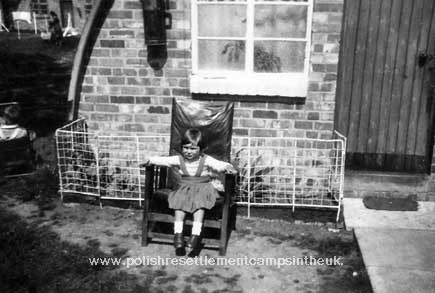 |
|
Teresa and friend
outside her Nissen hut |
Photos of me (Teresa) taken in
the camp |
|
| |
|
The camp soon became a small Polish village,
one of the huts was converted into a church and we had a Polish
priest on site. There was a nursery where I was placed while my
parents worked, a small school for children and a college,
"Josef Conrad School," for teenagers and young adults who needed
to learn English before they could start work. People in the camp
became friends forming a strong community, they were all in the
same circumstances, in a strange country where they could not
speak the language and did not know what had happened to their
relatives in Poland. So they rallied round helping one another to
find work in the surrounding area and sharing child care. People
were very patriotic, observing their traditions and bringing their
children up in a Polish spirit. Both my parents were sad that they
could not go back to their families. The war did not bring freedom
to Poland. To show his patriotism and solidarity my father placed
a plaque with a Polish eagle on the door of our Nissen hut. Haydon
Park become Little Poland. |
| |
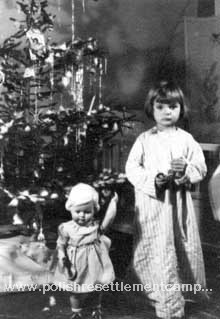 |
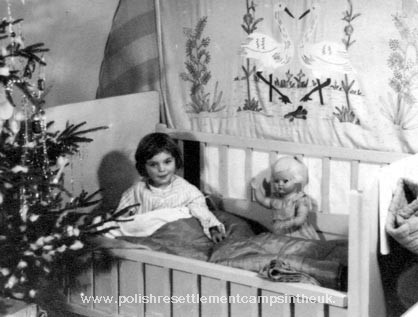 |
|
Teresa Stolarczyk
Christmas 1948. The hand embroidery storks enhance
Teresa's corner of the Nissen Hut. |
|
|
| |
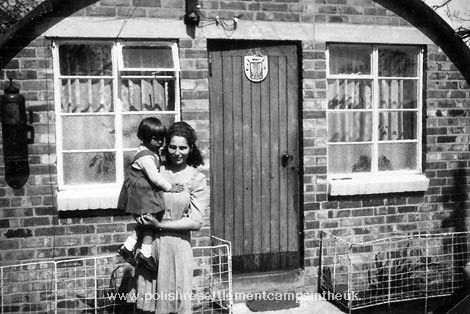 |
|
Juliana
Stolarczyk and daughter Teresa out side their Nissen Hut. |
|
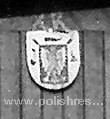 |
|
Polish eagle
on our door. |
|
|
In 1950 my
father went to the north of England looking
for work and found work in Bradford in a
woollen mill and some temporary accommodation,
so he returned to Haydon Park for me and my
mother. |
| |
|
We lived in
rented rooms and had to keep moving around as
most places did not like foreigners or
families with children. Both my parents worked
very hard and eventually saved enough money to
buy a house in Bradford. |
|
|
|
|
| They had two
further children, I have two brothers, both born in
Bradford The Polish community in Bradford was growing,
there was a church and Polish priest, two social clubs, a school and shops that sold Polish
food. |
| |
|
We also had Polish
football teams (my father was a manager) and dance
groups. Our family was very active in maintaining our
Polish culture. Many of the friends my parents
made in Haydon Park stayed with them all their lives and
I am still in contact with some of them. |
|
|
|
|
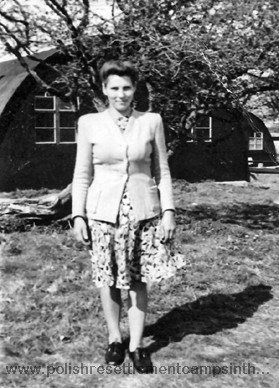 |
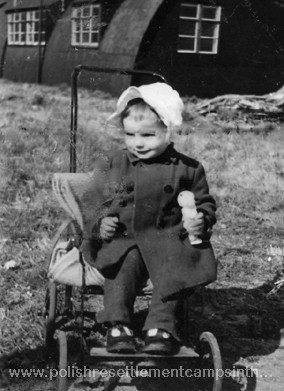 |
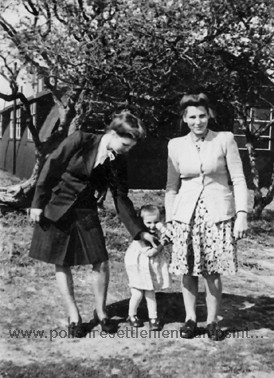 |
|
Juliana
Stolarczyk in Haydon camp |
Teresa Stolarczyk
|
Juliana
Stolarczyk with Teresa and a friend. |
|
|
|
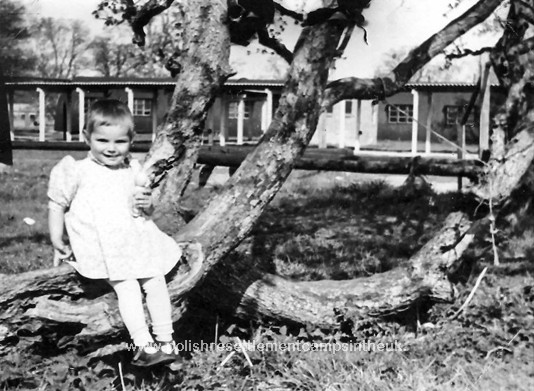 |
|
Teresa in Haydon Park,
you can just see the covered walk way in the back. |
|
|
|
|
At the end of 2004, sadly, our parents
died within three weeks of each other and are buried in the
Polish part of a Bradford cemetery. Father had some contact
with his family in Poland but mother searched all her life for
her family and sadly did not find them. After the death of our
parents my brothers and I felt that we needed some closure to
our parents lives in exile and their past. |
|
We trawled the internet for pre-war maps and
eventually turned up some 1890's Polish ones which showed where
our mother's village should have been. We went to the Ukraine in
2005 and with the help of a guide we found not only the actual
village but, in a nearby village, we found my mother's brother who
was able to take us back to my mother's village and show us my
mother's house and her mother's grave!! This was much more than we
could ever have hoped for. Returning to the Ukraine in 2006, to
discover more family, we also found my mother's birth
certificate. If only my mother had known of her brothers
existence....... But we have a happy ending as we now have an
uncle and relatives we never new of. |
| |
|
We also have made contact with the
daughter of the German farmer where my mother spent her war years
working. She remembered my mother well. It was a nice experience
to meet her too. |
| |
|
If you lived in Haydon Park and would like to
share your story and photos please contact me. |
|
|
